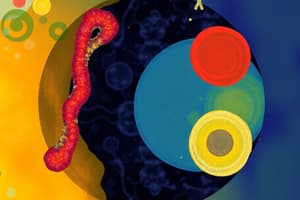Podcast
Questions and Answers
What is the primary role of mitochondria in a cell?
What is the primary role of mitochondria in a cell?
- Protein synthesis
- Cell division
- Transport of materials
- Energy production (correct)
Gram-negative bacteria have a thicker peptidoglycan layer than gram-positive bacteria.
Gram-negative bacteria have a thicker peptidoglycan layer than gram-positive bacteria.
False (B)
What are DAMPS and PAMPS in the context of the innate immune response?
What are DAMPS and PAMPS in the context of the innate immune response?
DAMPS are damage-associated molecular patterns, and PAMPS are pathogen-associated molecular patterns.
The inflammatory response is primarily aimed at _________ and clearing out pathogens.
The inflammatory response is primarily aimed at _________ and clearing out pathogens.
Match the following components of the immune response with their descriptions:
Match the following components of the immune response with their descriptions:
Which of the following are the three major pathways of the complement system?
Which of the following are the three major pathways of the complement system?
IgM and IgG are immunoglobulins that indicate historical exposure to infections.
IgM and IgG are immunoglobulins that indicate historical exposure to infections.
What term describes the process by which antibodies coat pathogens to enhance their phagocytosis?
What term describes the process by which antibodies coat pathogens to enhance their phagocytosis?
The four types of hypersensitivity reactions can be remembered with the acronym ACID, with A representing __________.
The four types of hypersensitivity reactions can be remembered with the acronym ACID, with A representing __________.
Match the following genetic transmission types with their characteristics:
Match the following genetic transmission types with their characteristics:
Flashcards
What is the cell membrane's role?
What is the cell membrane's role?
The cell membrane is a thin, flexible barrier that encloses the cell and controls what enters and leaves.
What is the role of ribosomes?
What is the role of ribosomes?
Ribosomes are responsible for protein synthesis. They read genetic information from messenger RNA (mRNA) and assemble amino acids into proteins.
What is Mitosis?
What is Mitosis?
Mitosis is a type of cell division that produces two identical daughter cells from a single parent cell. It's used for growth and repair.
What is Meiosis?
What is Meiosis?
Signup and view all the flashcards
What is innate immunity?
What is innate immunity?
Signup and view all the flashcards
Classical Complement Pathway
Classical Complement Pathway
Signup and view all the flashcards
Lectin Complement Pathway
Lectin Complement Pathway
Signup and view all the flashcards
Alternative Complement Pathway
Alternative Complement Pathway
Signup and view all the flashcards
Opsonization
Opsonization
Signup and view all the flashcards
CRISPR
CRISPR
Signup and view all the flashcards
Study Notes
Module 1 Exam Review
- Review of exam questions and answer choices are shown
- Various topics related to cell structure, mitosis, meiosis, immune and adaptive immune responses, bacteria, viruses, fungal infections, prions, inflammation, complement and complex system, immunoglobulins, hypersensitivity reactions and genetic transmission.
- Review of CRISPR, epigenetics, and their implications
Cell Structure
- Understand the roles of organelles (Mitochondria, Golgi apparatus, Cell membrane, Ribosomes).
Mitosis
- Review each mitosis phase.
- Understand how chromatids form.
Meiosis
- Review each meiosis phase.
- Compare and contrast meiosis and mitosis.
- Understand the purpose of meiosis.
Innate Immune Response
- Identify cells involved in innate immune response.
- Recognize host defenses against pathogens.
- Identify components and their roles for inflammation.
Adaptive Immune Response
- Identify cells involved in adaptive immune response.
- Understand DAMPS, PAMPS, and TLRs.
- Identify cells responsible for antibody creation.
Bacteria
- Distinguish between gram-positive and gram-negative bacteria.
- Identify infections caused by endotoxins and exotoxins.
- Understand how bacteria protect themselves against innate immune system cells.
Viruses
- Understand virus replication mechanisms.
- Understand retroviruses (and why HIV is one).
- Recognize cells responding to viral invasion.
- Understand how viruses avoid immune surveillance.
- Identify primary targets of HIV/AIDS.
Fungal Infections
- Understand fungal transmission mechanisms (e.g., inhaled spores in lung infections)
- Identify common fungal infections in immunocompromised individuals.
Prions
- Define prions.
- Understand prion infection mechanisms.
- Recognize diseases caused by prions.
Inflammation
- Differentiate between acute and chronic inflammation.
- Understand the primary response to infection.
Complement and Complex System
- Understand the 3 major complement pathways (classical, lectin, and alternative).
- Understand opsonization.
- Understand the role of complements and complexes in immune defense.
Immunoglobulins
- Understand the roles of different immunoglobulins in the immune system.
- Understand the structures of different immunoglobulins.
- Understand how IgM and IgG indicate exposure to infection.
Hypersensitivity Reactions
- Understand the four types of hypersensitivity reactions (A,C,I,D).
- Recognize examples of each type.
Genetics
- Know different types of genetic transmission: Autosomal dominant, Autosomal recessive, X-linked dominant, X-link recessive, and Mitochondrial.
CRISPR
- Understand CRISPR mechanisms.
- Review ethical issues associated with CRISPR.
Epigenetics
- Understand how epigenetics influence human genome change.
- Understand the possible reasons behind increased chromosomal abnormalities with older maternal and paternal ages.
Studying That Suits You
Use AI to generate personalized quizzes and flashcards to suit your learning preferences.




